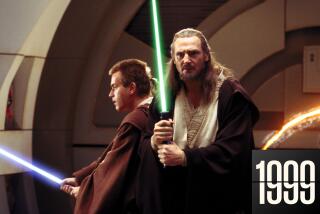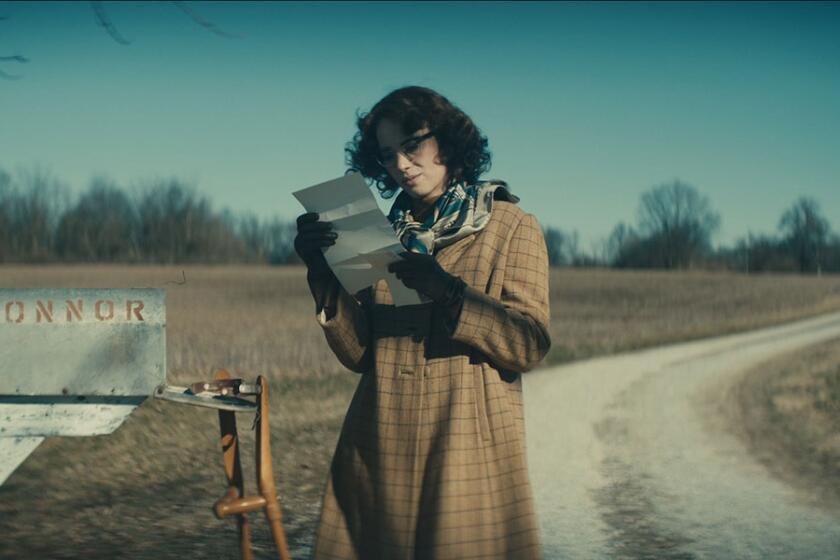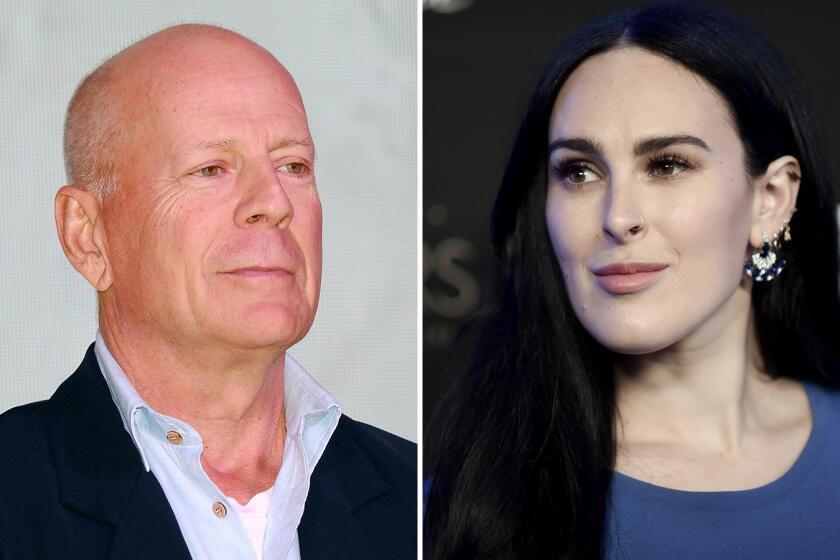Demise of Sex Farce: The Mystery Is Gone
No one wrote about sex with more breathless comic verve than Preston Sturges, the ringmaster of 1940s screwball comedy. In “The Palm Beach Story,” Mary Astor, who plays a ditsy socialite, throws herself at Joel McCrea, the failed inventor of a midair airplane landing strip. (Screwball comedies are full of ditsy socialites and madcap inventors, two characters you don’t get to see much of in, say, a Rob Schneider movie).
When Astor makes a pass at McCrea, he says, “You never think of anything but Topic A, do you?” She replies: “Is there anything else?”
For Sturges, as well as so many other great American directors, from Billy Wilder to Woody Allen, sex was Topic A, the lubricant that gave filmmakers the opportunity to revel in a giddy array of ingenious, outrageous and raucously funny satires and farces. Unfortunately, sex has almost disappeared from the alphabet in comedy today, at least in movies made for adults. In fact, the sex farce, which flourished almost from the minute movies could talk to the 1970s--from “It Happened One Night” to “Shampoo” and “Annie Hall”--has expired as a genre, joining westerns, musicals and private-eye movies in Hollywood’s Boot Hill.
The final nail in the coffin was “Town & Country,” the $85-million New Line Cinema fiasco that limped into the theaters 10 days ago--it’s grossed a dismal $5.2 million so far--mortally wounded not only by bad reviews and a string of stories about its troubled production history, but by a nagging sense that it was a movie that should have been released in 1975, when marital infidelity was still a hot topic (and Warren Beatty, Goldie Hawn and Diane Keaton were still hot stars).
The film wasn’t without its share of laughs. Unfortunately, they could have easily been found in any number of 1930s sex farces, which, like “Town & Country,” were populated with the idle rich and their oddball friends and service personnel. The lineup of characters in “T&C;,” who include a nutty heiress, a gun-nut father, a neurotic cellist and a maid whose boyfriend speaks in fractured English, wouldn’t be at all out of place in the Sturges-written “Easy Living” or the Billy Wilder-written “Midnight,” both of which were made more than 60 years ago. There’s even a costume party sequence with Beatty running around in a polar bear outfit that’s straight out of a Peter Sellers movie like “A Shot in the Dark” or “What’s New, Pussycat?” a 1965 sex farce that was originally intended as a Beatty vehicle.
As a commercial enterprise, the film had a glaringly obvious flaw: who wanted to see fiftysomething (and in Beatty’s case, sixtysomething) actors hopping from bed to bed? “When Warren and Goldie were having sex on the couch, with Warren’s pants around his ankles, all I could think was--this is like watching my parents have sex,” says People magazine film critic Leah Rozen, who panned the film. “It made me feel old and I thought, if I feel old, think of how old these people are that I’m watching.”
But “T&C;” didn’t fail simply because its actors were too long in the tooth. It failed for the same reason that “What Planet Are You From?”--the Garry Shandling sex farce--was DOA at the box office last year. It was a movie out of sync with its time. Today’s gifted young filmmakers are looking elsewhere for their kicks. Whatever movies come next from Paul Thomas Anderson, David Fincher, Guy Ritchie, Robert Rodriguez, Wes Anderson or M. Night Shyamalan, it’s hard to imagine that a sex farce would be on the list--they simply aren’t part of their filmic vocabulary. It would be like trying to persuade your teenage son to blow off hip-hop and play the blues.
Every few years somebody tries to update a classic screwball comedy--and fails miserably, whether it’s Julia Roberts and Nick Nolte in “I Love Trouble” or Burt Reynolds and Kathleen Turner in “Switching Channels,” a botched attempt to redo “The Front Page” in TV news. Just the other day one of the talent agencies was hawking a spec script billed as a modern-day “Bob & Carol & Ted & Alice.” After hearing the pitch, one commercially minded producer I know passed. “It’s the kiss of death to do that kind of comedy today,” he told me. “Nobody wants to see that kind of wife-swapping sex anymore.”
The more commonplace sex has become in our culture, the less of a place it has in our movies. It’s no coincidence that sex farces were most prevalent from the Depression to the pre-sexual revolution 1960s. Sexual humor needs sexual repression to work its magic. Screwball comedies were full of knockabout physical activity; in Sturges’ “The Lady Eve,” Henry Fonda can hardly go five minutes without taking a pratfall, usually after tripping over Barbara Stanwyck’s bare, outstretched leg. “The tussling and piggyback rides were a kind of code for sex,” says New York magazine critic Peter Rainer. “But we have a different culture today, where grown-ups can’t act foolish or romantic like that.”
*
Without taboos or restrictions, there’s none of the tension that gives sexual farces their subversive comic punch. In fact, today’s culture is the opposite of repressed--it’s exhibitionist. It’s routine to turn on “The Jerry Springer Show” and watch someone share their innermost sexual secrets (“I Slept With My Girlfriend’s Stepmother!”) with millions of total strangers. The mystery of sex is gone, which as screenwriter Ed Solomon points out, was the engine that drove sex farces.
“The mystery was the bridge between what you have and what you want,” he says. “And that mystery and innocence is gone forever.”
TV has also stolen a healthy chunk of Hollywood’s sexual turf. A host of sitcoms spends an inordinate amount of time talking about sex, whether it’s “Will & Grace,” “Ally McBeal” or HBO’s more graphic “Sex in the City.” “The movies have done sex already,” says critic David Thomson. “We don’t seem very interested in seeing it on the big screen, perhaps because people would rather watch ‘Friends’ to see if David Schwimmer and Jennifer Aniston will ever get together.”
And then there’s so-called reality TV, which has managed to turn the mystery of sex into the banality of exhibitionism. How do you top “Chains of Love,” where a hunky oaf and four babes are chained together for days on end in the hopes of setting off some erotic sparks?
Sex farces have also disappeared from the movies because they depend on unlikable characters, which tend to get an immediate thumbs-down from test audiences. But without a cad, or at least a hero who makes a dizzying series of terrible blunders, you have no farce. Imagine Billy Wilder trying to make an amoral comedy about a young executive who gets ahead by pimping for his philandering superiors--the plot of “The Apartment”--in a studio environment that demands tidy, happy endings. As screenwriter Les Bohem puts it, risk-adverse studio executives want characters to “start out perfect and only get better.”
Perhaps that’s why the few engaging sex comedies in recent years have been imported from Spain, thanks to Pedro Almodovar, and England, with such movies as “Bridget Jones’s Diary” and “Four Weddings and a Funeral” that didn’t have to pass such stringent likability tests. (Although even with “Bridget,” some fans of the novel complained that the title character lost some of her tartness in her translation to film).
“T&C;’s” lamest moment, where Beatty makes a groveling apology to his wife for his transgressions, was the product of re-shoots mandated by negative test-screening reaction. Moviegoers felt Beatty, as an adulterer, hadn’t been contrite enough in the original. Despite the prevalence of sex all over the pop-culture dial, Americans remain a fairly prim, Puritanical people. We certainly are uncomfortable enough about sex that we prefer to get our kicks in private, either on cable TV or on the Internet, where pornography is by far the most profitable form of Web entertainment.
*
The one place where sex comedy is still alive and well is with 15-year-old boys, who have made hits out of sex farces such as “American Pie,” “There’s Something About Mary,” “Road Trip” and “Austin Powers.” It makes perfect sense. If sex comedies flourished in an era of sexual scarcity, then it’s fitting that sex comedies today would have their greatest appeal for the one segment of the population where getting some action is still a big deal. As in real life, the sex in teen movies is, for the most part, leers and dirty talk, but little action. Today’s teenagers prefer their sexual comedy bathed in titillating fantasy.
It just goes to show--every generation sees Topic A in a different light. In the Depression-era ‘30s, sex comedies made fun of the stuffy rich; in the swinging ‘60s, they spoofed the battles between the sexes. Today’s young moviegoers prefer to see the world as if it were one giant MTV spring break vacation fantasy, where sex flows like mountain spring water. As we get older, we seem to get less comfortable with sex, or at least more aware of its endless complications.
In a strange way, the arrival of sexual freedom took a lot of the fun out of movie sex by making it more of a tangible reality. The best sex comedies were champagne effervescent, sworn enemies of stuffiness and self-importance and full of characters who blew all their money and broke all the rules along their way to unlikely happiness. They’re just not a good fit with today’s pop culture, which celebrates winning at all costs. When it comes to sex, it isn’t really all that funny if you can have your cake and eat it too.
*
“The Big Picture” runs every Tuesday in Calendar. If you have ideas, comments or criticism, e-mail them to patrick.goldstein@latimes.com
More to Read
Only good movies
Get the Indie Focus newsletter, Mark Olsen's weekly guide to the world of cinema.
You may occasionally receive promotional content from the Los Angeles Times.






